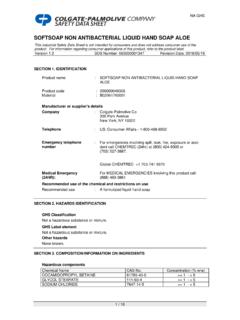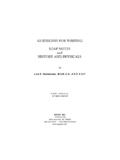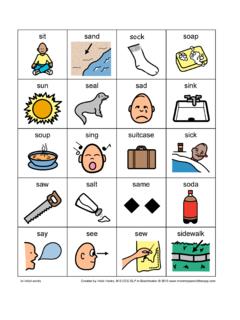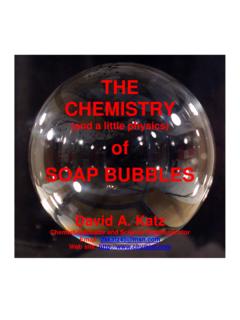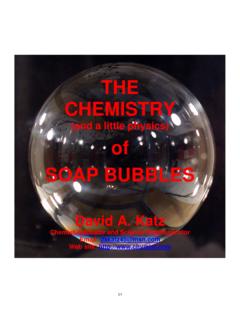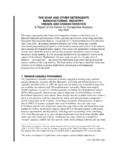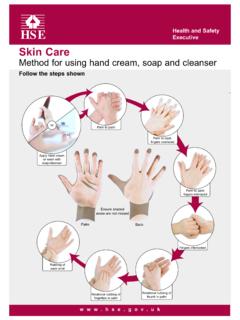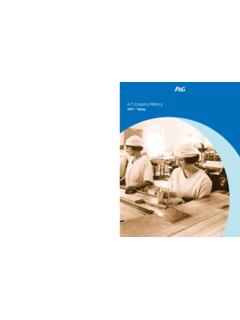Transcription of Homemade Soap
1 Homemade Soap Compiled by Kathy Miller - see info at In trying to put together this handout, I realize I have a ton of stuff posted on the web! This is just part of it and to get you started. If you'd like to visit the web page for more information on soapmaking, the URL is: < >. Notes on Soapmaking (Some from old Pennwalt Corp. leaflet). 1. Never use lye on aluminum utensils (lye acts upon them). For small batches of soap, enameled or granite ware is suitable and for larger batches, an iron kettle may be used. 2. All grease should be pure and clean to obtain soap with a clean, wholesome odor.
2 3. Measure accurately. Be careful about temperatures. 4. Ammonia, kerosene, carbolic acid, etc., when added to soap help it little, if any, as the lye usually neutralizes them. They increase cost and may make soap harsh on skin. 5. Coldness makes a hard, brittle soap. 6. Excess lye makes a coarse, flinty soap that will crumble when shaved. Soap should have a smooth, velvety texture that curls when shaved. It should not bite the tongue when aged. 7. Use the all-purpose soap for toilet soap, a shampoo, for washing prints, lingerie, hose and other delicate fabrics.
3 8. The following fats (for soapmaking) are listed in the order of their desirability: Tallow, lard and their combinations, olive oil, other vegetable oils. Mineral oils will not make soap. 9. Poultry fat should be combined with other fats, as soap made from it alone is soft and spongy. 10. Aging always improves soap. Soap made from lard or soap that has been boiled requires longer aging before it becomes hard and ready for use. 11. Instead of storing rinds and meats scraps, extract the fat; store in a tightly covered container in a cool, dry place.
4 12. Make the fat into soap as it accumulates and let the soap age rather than allow the fat to get too old and rancid. 13. There need never be a failure in soapmaking. If separation occurs, it can be reclaimed. 14. Where you find your grease has become rancid or contains materials other than fats, boil in large quantity of water, allow to cool, skim off grease, and then follow the directions in the recipe for soapmaking. Fats or Grease to Use You must have fat or grease to make soap; it cannot be made from lean meat scraps. Tallow and lard make the best soap.
5 Fats that have no cooking value, such as meat fryings, cracklings, meat trimmings and other refuse fat can be used. Certain vegetable oils are sometimes used. Mineral oil or mineral grease will not make soap. Soapmaking Handout- Page 1. Preparing Fat Good soap requires fats that are free from dirt, rancidity, lean meat, salt and other impurities. Fats may be grouped in three classes: 1. Fat rendered from tallows, meat trimmings, rinds and other meat scraps. This fat is ready for soap. 2. Meat fryings and other refuse fats. This class of fat should be washed as follows: Add an equal amount of water and bring it to the boiling point.
6 Remove from fire, stir, add cold water (1 qt. to 1 gal. of the hot liquid). The cold water precipitates foreign substances. The clean fat comes to the top. Remove the fat when firm. Note: Some fats require a second washing. Wash a very rancid fat at least twice. 3. Cracklings. For pressed cracklings remove fat as follows: To every four pounds or one gallon of pressed cracklings, add one level tablespoon of lye, and water to twice the depth of the cracklings. Cover and boil one hour. Remove from fire and when it stops boiling pour cold water over it and proceed as in 2 above.
7 Treat unpressed cracklings the same as pressed cracklings, except use one level teaspoon of lye instead of one tablespoon to four pounds of cracklings. Note: Sixteen pounds of cracklings - (approximately four gallons) can be boiled at one time. Remove fat from the cracklings after butchering and store until ready. Compiler's Note: The above sounds pretty messy and is. I usually have bought pure fat from the butcher or have friends that have given me their lard/tallow after purchasing sides of meat. If you order fat from a local butcher, be sure to get beef kidney fat.
8 You might have to buy a certain quantity for him to order (I ordered 40 pounds last time and paid approximately 50 cents per pound, but it renders out almost 95% and is a great buy). The easiest rendering method for me is to cut the fat up into chunks and melt it down in my microwave oven. I use a covered heat-proof casserole dish for this purpose and after the cracklings are getting brown and are shrinking toward the center (but not burning yet!), I lift them out and pour the fat through a sieve. This method allows you to render what you need and do smaller batches without tying up your kitchen for the whole day (such as using the stove method or in the oven).
9 It smells, for sure, but it's easier to deal with the leftover scraps for me when they are all crispy than to have to pull them out of a pot of water when they look pretty disgusting! If you don't have a source for lard (pig fat) you can buy that ready-to-go at many grocery stores in the baking section or possibly in the dairy case. Tallow or Lard Recipe with Basic Instructions (Original from Pennwalt Corp.): To make about 9 pounds of pure, hard, smooth soap suitable for toilet, laundry or soap flakes, follow this simple recipe: One 12 ounce can of lye 2 1/2 pints cold water 5 pounds 10 oz.
10 Clean fat (tallow or lard or some combination of tallow and lard). Note: (Approximately pints or 13 standard cups of liquid fat.). Dissolve lye in water (never use an aluminum container). Stir until dissolved and let cool to correct temperature (temperature chart is below). Melt fat to clear liquid and let cool gradually to correct temperature. Stir from time to time to prevent the crystals of fat reforming. After both are in the correct temperature range, pour the lye solution into the fat in a thin, steady, stream with, even stirring. (Note: I've found that transferring the lye solution to a Rubbermaid plastic a pouring this easy to control myself.)
